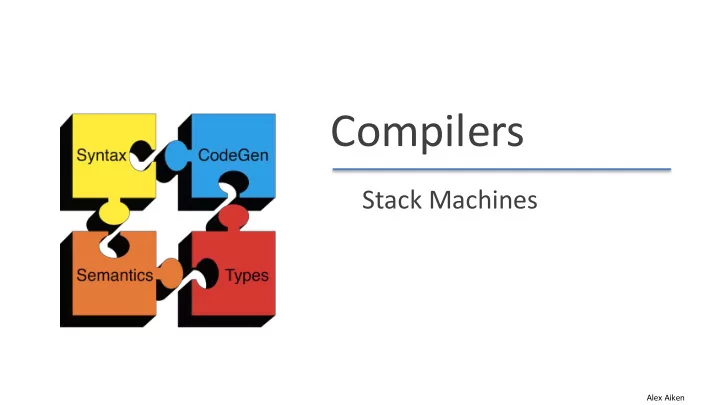

Compilers Stack Machines Alex Aiken
Stack Machines • Only storage is a stack • An instruction r = F(a 1 ,…a n ): – Pops n operands from the stack – Computes the operation F using the operands – Pushes the result r on the stack Alex Aiken
Stack Machines Alex Aiken
Stack Machines • Consider two instructions – push i - push integer i on the stack – add - add two integers – A program: push 7 push 5 add Alex Aiken
Stack Machines • Stack machines are a very simple machine model – Leads to a simple, small compiler – But not necessarily one that produces very fast code Alex Aiken
Stack Machines • Location of the operands/result is not explicitly stated – Always the top of the stack • In contrast to a register machine – add instead of add r 1 , r 2 , r 3 – More compact programs • One reason that Java bytecode uses stack evaluation Alex Aiken
Stack Machines • There is an intermediate point between a pure stack machine and a pure register machine • An n-register stack machine – Conceptually, keep the top n locations of the pure stack machine’s stack in registers • Consider a 1-register stack machine – The register is called the accumulator Alex Aiken
Stack Machines • In a pure stack machine – An add does 3 memory operations – Two reads and one write to the stack • In a 1-register stack machine the add does acc acc + top_of_stack Alex Aiken
Stack Machines • Consider an expression op(e 1 ,…,e n ) – Note e 1 ,…,e n are subexpressions • For each e i (0 < i < n) – Compute e i – Push result on the stack • Pop n-1 values from the stack, compute op • Store result in the accumulator Alex Aiken
Stack Machines Alex Aiken
Stack Machines After evaluating an expression e, the accumulator holds the value of e and the stack is unchanged. Expression evaluation preserves the stack. Alex Aiken
Stack Machines Code Acc Stack acc 3 3 <init> push acc 3 3, <init> acc 7 7 3, <init> push acc 7 7, 3, <init> acc 5 5 7, 3, <init> acc acc + top_of_stack 12 7, 3, <init> pop 12 3, <init> acc acc + top_of_stack 15 3, <init> pop 15 <init> Alex Aiken
Stack Machines Given the current state of the stack and accumulator, what is the next line of Current: code to generate for the code fragment Acc : 5 (2 * 3) + 5? Stack: 6,<init> push acc pop acc 6 acc acc + top_of_stack
Recommend
More recommend